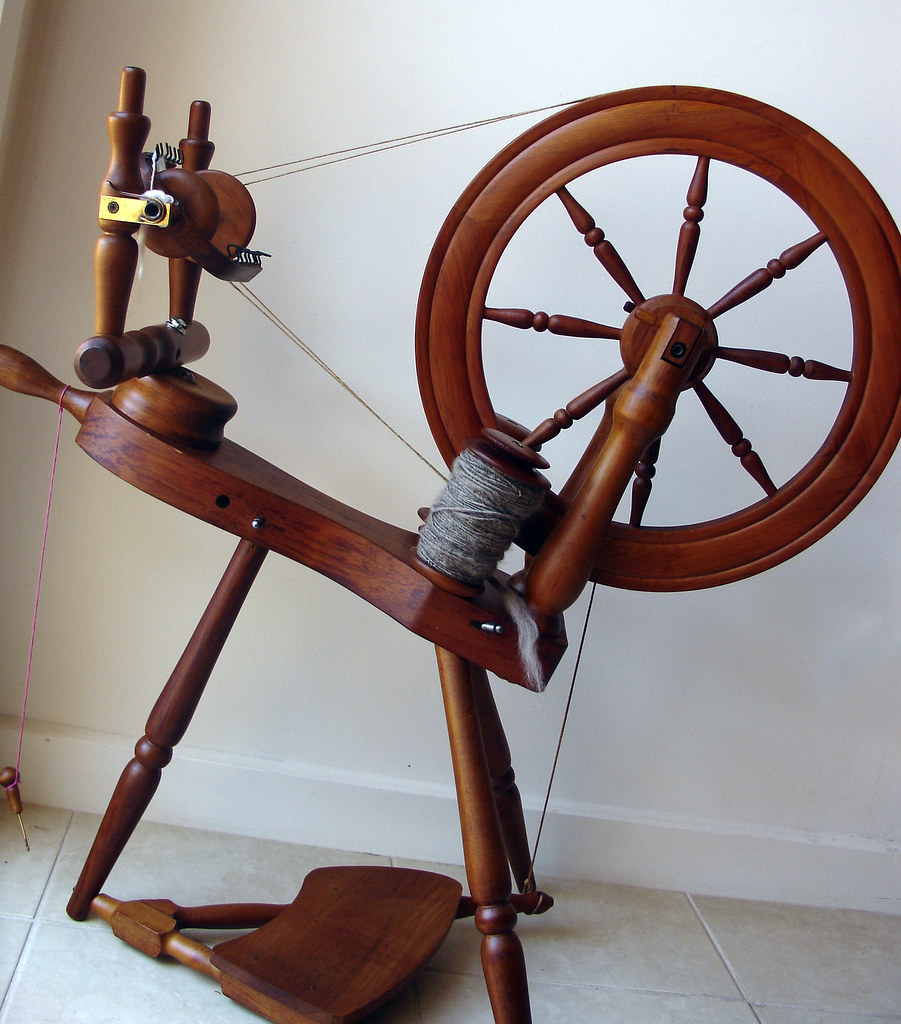Unraveling the Legacy of the Spinning Wheel: Weaving Through Time – Throughout history, the spinning wheel has been an emblem of human ingenuity and progress. This timeless tool has played a significant role in shaping societies, economies, and even revolutions.
Unraveling the Legacy of the Spinning Wheel: Weaving Through Time
From its humble beginnings to its modern-day variations, the spinning wheel stands as a testament to the power of human innovation and the impact of technology on our lives. Join us on a journey as we unravel the legacy of the spinning wheel and explore its profound influence on the fabric of civilization.

- The Birth of a Revolution: The origins of the spinning wheel can be traced back to ancient times, with its roots deeply entwined in the history of textile production. It was during the Middle Ages, however, that the spinning wheel underwent a remarkable transformation. With the addition of a flyer and a spindle, the “great wheel” or “walking wheel” was born. This invention revolutionized the process of spinning fibers, allowing for greater efficiency and productivity.
- Spinning Wheels: Engines of Change: The advent of the spinning wheel marked a turning point in human history, especially for the textile industry. Prior to its invention, spinning yarn was a laborious task performed by hand with a drop spindle. The spinning wheel’s introduction brought about a significant leap forward in productivity, empowering people to produce yarn on a much larger scale. This advancement played a pivotal role in the growth of the textile industry, leading to increased trade, economic prosperity, and societal changes.
- Weaving Together Communities: The spinning wheel not only transformed textile production but also had profound social implications. In many communities, spinning wheels became a focal point of gathering and social interaction. Women would come together to spin yarn, share stories, and pass down ancestral knowledge. The spinning wheel became a symbol of community cohesion, fostering a sense of belonging and cultural heritage.
- Spinning Wheels and Empowerment: The spinning wheel also played a pivotal role in empowering women. Historically, spinning and weaving were predominantly women’s work, and the spinning wheel provided them with greater independence and economic autonomy. Women could earn income by spinning yarn, contributing to their families’ financial stability. Moreover, the ability to spin their own yarn empowered women to create their own clothing and textiles, reducing dependence on external sources.
- Symbolism and Cultural Significance: Beyond its practical implications, the spinning wheel carries significant symbolism across different cultures. It has been associated with concepts of fate, time, and transformation. The image of the spinning wheel appears in folklore, mythology, and literature, representing the cyclical nature of life, the interconnection of past and present, and the power of transformation and self-discovery.
- Modern Adaptations: In today’s technologically advanced world, the spinning wheel has evolved into various forms to suit contemporary needs. Electric spinning wheels have replaced manual ones, offering greater speed and efficiency. Furthermore, spinning wheels have also found a place among artisans and hobbyists, who embrace the craft as a form of creative expression and a means of connecting with traditions.
Alternative Names used for the Spinning Wheel
The spinning wheel is known by various names across different cultures and regions. Here are some alternative names for the spinning wheel:
- Great Wheel: This term refers to the large vertical spinning wheel with a large drive wheel and a spindle. It is also called the “walking wheel” because the spinner would walk back and forth while operating it.
- Walking Wheel: This name emphasizes the walking motion of the spinner as they move back and forth to turn the wheel.
- Saxony Wheel: The Saxony wheel is a type of spinning wheel that originated in Saxony, Germany. It is characterized by its compact design, double-drive system, and horizontal orientation.
- Charkha: The charkha is a traditional spinning wheel used in India. It is a portable, hand-cranked wheel commonly associated with Mahatma Gandhi and his promotion of spinning as a means of self-reliance and independence during India’s struggle for independence.
- Castle Wheel: The castle wheel refers to a spinning wheel design in which the flyer assembly and bobbin are mounted vertically on top of a tall, castle-like structure. This design provides stability and allows for easier access to the spinning components.
- Spinning Jenny: The spinning jenny was an early spinning machine invented by James Hargreaves during the Industrial Revolution. It allowed multiple spindles to be operated simultaneously and significantly increased productivity compared to traditional spinning wheels.
- Spinning Mule: The spinning mule, developed by Samuel Crompton, was another spinning machine that combined the features of the spinning jenny and the water frame. It further improved productivity by utilizing both mechanical and human power.
- Flax Wheel: The flax wheel, also known as a linen wheel, is a spinning wheel specifically designed for spinning flax fibers into linen thread. It typically has a distaff, which holds the flax fibers, attached to the side of the wheel.
These alternate names demonstrate the diverse cultural and historical variations of spinning wheels and the different technologies and designs associated with them.
Lesser-known facts about the Spinning Wheel
While the spinning wheel holds a significant place in history, there are some lesser-known facts about this ingenious invention. Delve into these intriguing details that shed light on lesser-explored aspects of the spinning wheel:
- Ancient Origins: While the Middle Ages marked a significant development in spinning wheel technology, the concept of spinning fibers using a wheel-like apparatus dates back much further. Archaeological evidence suggests that early versions of spinning wheels may have existed as early as 1000 BCE in India and China. These early spinning wheels were often operated by hand or foot and lacked the flyer and spindle mechanisms of their later counterparts.
- Cultural Variations: The spinning wheel’s design and functionality varied across different regions and cultures. For example, the Indian charkha, popularized by Mahatma Gandhi during the Indian independence movement, featured a portable and compact design suitable for hand spinning cotton. In contrast, the Norwegian spinning wheel, known as the “great wheel” or “walking wheel,” had a large vertical wheel that required the spinner to walk back and forth while operating it.
- Revolutionary Impact: The spinning wheel played a crucial role in the Industrial Revolution. While the rise of factory production and mechanization brought about significant changes in the textile industry, many rural areas continued to rely on spinning wheels. The cottage industry model, where independent spinners worked from home, remained prevalent well into the 19th century. This decentralized system allowed families to supplement their income while preserving traditional spinning techniques.
- Symbolism in Literature and Art: The spinning wheel’s symbolic significance extends beyond folklore and mythology. It has also found a place in literature and art. In the fairy tale “Sleeping Beauty,” the protagonist pricks her finger on a spindle and falls into a deep slumber, highlighting the transformative power and potential dangers associated with spinning. Additionally, famous paintings such as “The Spinning Wheel” by Vincent van Gogh and “The Spinning Wheel” by Émile Bernard capture the essence of the spinning wheel in visual art.
- Development of Spinning Machines: The spinning wheel paved the way for the invention of more sophisticated spinning machines. In the late 18th century, the spinning jenny and later the spinning mule were developed, further revolutionizing textile production. These machines automated the spinning process and increased productivity, eventually leading to the establishment of large-scale textile mills.
- Contemporary Revival: While the spinning wheel may seem like an artifact of the past, it continues to thrive in modern times. The art of hand spinning and the use of spinning wheels have experienced a revival as part of the broader interest in traditional crafts and sustainable practices. Many individuals now embrace spinning as a creative hobby, incorporating natural fibers and hand-dyed yarns into their projects.
- Cultural Heritage: The spinning wheel holds deep cultural significance in many communities worldwide. It is an integral part of cultural festivals, demonstrations, and reenactments, where skilled artisans showcase their spinning techniques and pass down traditional knowledge to future generations. Such initiatives help preserve the craft’s heritage and ensure its survival in the face of modernization.
While these lesser-known facts about the spinning wheel add further depth to its rich history, they highlight the enduring legacy and cultural impact of this remarkable invention. The spinning wheel’s story continues to spin, connecting us to our past while inspiring future generations to appreciate the artistry and innovation behind this timeless tool.
Conclusion
As we reflect on the legacy of the spinning wheel, we cannot help but marvel at its enduring impact on human civilization. From its humble beginnings to its transformational effects on economies, communities, and individual lives, the spinning wheel stands as a testament to the ingenuity of our ancestors. It serves as a reminder that even the simplest tools can shape the course of history and leave an indelible mark on our cultural fabric. As we move forward, let us not forget the lessons embedded in the spinning wheel’s timeless legacy and continue to celebrate the power of human innovation.


